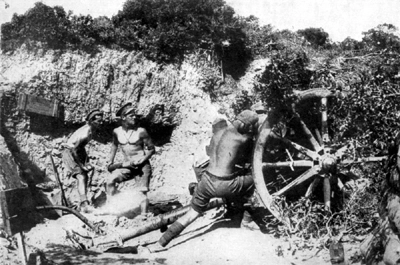Soldiers, it was decided, would be needed after all.
Lord Kitchener placed in charge Sir Ian Hamilton, but sent him into battle with out-of-date maps, inaccurate information and inexperienced troops. A force of British, French and ANZAC (Australian and New Zealand Army Corp) troops landed on the Gallipoli peninsula on 25 April. The Turks were waiting for them in the hills above the beaches and unleashed a volley of fire that kept the Allied troops pinned down on the sand. As on the Western Front, stalemate ensued. The Allies, under constant attack, took cover as best as they could among the rocks, with only the beach behind them and, without shade, exposed to searing sun. Their fallen comrades lay putrefied and bloated beside them, the stench filling the air.

Australian artillery during the Gallipoli Campaign, 1915
On 6 August, the British launched a renewed attack. The ANZACs would attempt to break out from their beach and take the high ground whilst a British contingent of 20,000 new troops led by General Sir Frederick Stopford would land on Sulva Bay on the north side of Gallipoli. Stopford’s men made a successful landing, outnumbering the enemy by fifteen to one. Instead of pressing home their advantage, the general gave his men the afternoon off to enjoy the sun while he had a snooze. Hamilton advised but did not order an advance. By the time Stopford did advance, it was too late, the Turks had rushed men into position and the stalemate of before prevailed.
The Allied troops endured further months of misery. 70 per cent of the ANZACs suffered from dysentery, where medical care, unlike the Western Front, was at best primitive. With the onset of winter, the troops, without shelter and exposed to the elements, suffered frostbite. Kitchener was dispatched by the British government to check on the situation. Appalled, he returned to London and urged evacuation. Finally, in January 1916, the curtain fell on the whole sorry ‘side show’. A contrite Churchill resigned and punished himself by joining a company of Royal Scot Fusiliers on the Western Front. He returned to politics a year later and in 1917 was appointed Minister of Munitions. Meanwhile, Kitchener, who had been progressively side-lined, was sent on a diplomatic mission to Russia. On 5 June 1916, his ship, the HMS Hampshire, hit a German mine off the Orkney Islands and sunk. His body was never found.
During 1915, Germany dangled a bait in front of neutral Bulgaria – help us defeat Serbia and we’ll give you Macedonia, territory Bulgaria lost to Serbia after the Balkan War of 1912–13. Unable to resist, the Bulgarian king, the German-born ‘Foxy Ferdinand’, Ferdinand I, entered the war in October 1915 and immediately joined the German–Austrian assault on Serbia.
Twice, in 1914, the Austrian–Hungarian’s ventures in Serbia had met with defeat. Not this time. In October 1915, the Allies, attempting to aid Serbia, sent a force to the Greek port of Salonika (now Thessaloniki) from where it was only fifty miles to the landlocked Serbia. Too late. Heavily outnumbered, Belgrade fell and the Serbian army was forced into a desperate retreat over the mountains of Albania, struggling in the snow alongside thousands of Serbian refugees. Starvation, cold and disease decimated their number, both soldier and civilian alike. Eventually, the remnants arrived at the Adriatic coast, where they were rescued by the Allies and evacuated to Corfu. Austria–Hungary had avenged the death of Archduke Franz Ferdinand and Serbia had paid for it by losing one-sixth of her whole population.
The Allied troops in Salonika however stayed put to dissuade the Greeks from joining the German cause (after all, they reckoned, the Greek king was married to the Kaiser’s sister). And there the Allied troops remained for the rest of the war, half a million men, mocked as the ‘the Gardeners of Salonika’, whose services could have been better used elsewhere.
1 comment